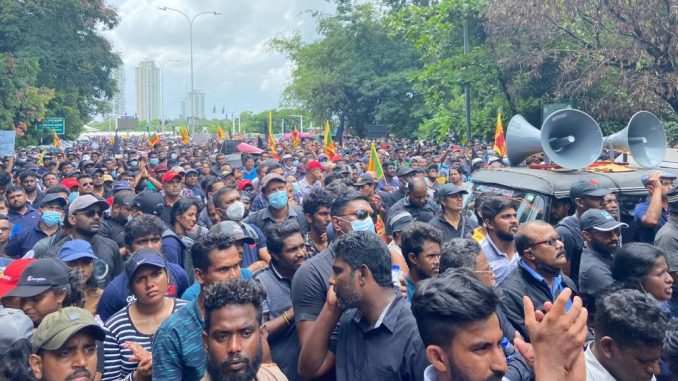
By Vicente Gaynor
On Monday, May 9, the Prime Minister of Sri Lanka resigned in the midst of a social uprising against the austerity and repression of the government headed by his brother, President Gotabaya Rajapaksa.
The enraged masses targeted the obscene riches of the ruling elite that has long been imposing misery and hunger on them. The Rajapaksa family’s mansion and the collection of dozens of luxury cars parked there were set on fire, the cars of other top officials were thrown into the river, and a legislator and his bodyguard were killed after shooting and wounding two protesters. State repression, meanwhile, left at least 9 people dead and 250 injured.
The protests in Sri Lanka began in early March. The country, an island of 20 million inhabitants in the Indian Ocean, is facing the biggest economic crisis since its independence in 1948, marked by sharp increases in fuel prices, food shortages, energy blackouts, record levels of inflation and an accumulated external debt of almost 50,000 million euros.
The Rajapaksa dynasty
Sri Lanka has been ruled by the Rajapaksa family since the end of a long civil war in 2009. Gotabaya Rajapaksa is the president; his brother Mahendra is the recently resigned prime minister; another brother, Basil, is finance minister; yet another brother, Chamal, is Minister of Agriculture, and a nephew is Minister of Sports.
With the support of imperialism, this family has plundered the country and obscenely enriched itself, while constantly curtailing democratic liberties. This is why the protests have targeted the Rajapaksas and their properties, and demand the resignation of the entire family.
Economic and social crisis
Gotabaya Rajapaksa became president in 2019, promising to lower inflation. However, he increased the emission of money to cover the lack of income and kept the dollar artificially at 200 rupees for five consecutive months, which liquidated the country’s reserves.
The coronavirus pandemic impacted on that fragile economy hard, devastating tourism and agricultural trade. In the last two years, the country’s reserves have decreased 70%, reaching the lowest point in the country’s history.
In recent months, the government entered negotiations with the IMF to avoid a default and with China to try to arrange a new loan from Beijing. Sri Lanka has already handed over the port of Hambantota to China for a 99 year lease, in exchange for reducing other debts previously contracted with the Eastern giant.
Meanwhile, food and fuel became scarce, hospitals couldn’t get basic supplies, schools ran out of paper, and the people got fed up.
Social uprising
On March 31, thousands of people marched demanding the president’s resignation. Without being called by any opposition party, the protest began in the capital Colombo and quickly spread throughout the country.
The government declared martial law, but the mobilized people did not comply and the protests intensified. The next day, hundreds of thousands marched in Colombo and raised barricades, facing a brutal repression and hundreds of arrests.
The government doubled down, imposing a 36-hour curfew and calling in the army to patrol the streets. This caused an indignation that multiplied the mobilization. Millions took to the streets against the curfew.
The following day, the government blocked social networks, yet, in spite of this the most massive mobilizations in the country’s history were carried out. This finally led to the resignation of some ministers, but not to the solution of any of the problems that the people suffer. A new uprising was inevitable.
On May 9, the masses took to the streets again, with greater anger and resolve against the ruling family. This time, the prime minister had to resign, and the government entered an acute political crisis.
The current crisis
After dissolving the cabinet and calling on all opposition parties to form a national unity government, the president installed a veteran of the country’s traditional politics as interim prime minister.
Ranil Wickremesinghe, 73, was Prime Minister of Sri Lanka from 1993 to 1994, from 2001 to 2004, 2015 to 2018, and from 2018 to 2019. Although his designation reflects Rajapaksa’s intentions to cling to power and impose continuity, the newly elected Wickremesinghe has had to signal some concessions to the mass movement.
For starters, he has pledged to withdraw the “shoot to kill” order that had been in place among security forces for the last few weeks. He has also promised to initiate the necessary procedures to repeal the 20th Amendment of the Constitution and thus reduce presidential powers; and appointed a special commission to resolve the current crisis of shortages of essential foods, after holding meetings with the ambassadors of the US, China, Japan and India.
However, far from resolving anything, the crisis experienced by the people of Sri Lanka only continues to worsen. On May 16, the new interim minister said that, of the foreign currency reserves that totaled 7.5 billion in November, “today the Treasury can hardly find a million;” that “at the moment we have oil for only one day” and that the situation is more likely to worsen during the next two months.
Which is why it is also likely that the mass upsurge that began in March against the Rajapaksa regime will return to the streets until they get rid of them. None of the problems they suffer can be resolved within the imperialist and semi-colonial capitalist system that rules the country.








